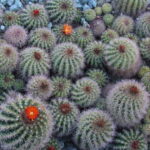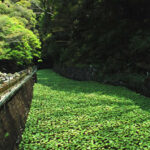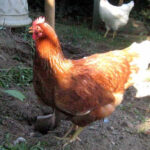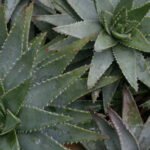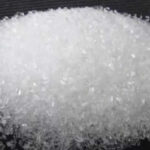Plums are an excellent plant to grow, especially in North America. Growers should be aware of the necessary care for plum trees, and they should also consider what plum tree diseases they may have to contend with during the growing season.
By understanding what bacteria, fungi, viruses, and oomycetes affect different types of plum trees, gardeners can have a healthy and happy tree. Healthy trees promote hefty yields. And good yields mean a lot more delicious plum flavor throughout the year.
So in this piece, we’ll roll through the most common plum diseases out there. We’ll discuss their symptoms, and how to control treatable diseases. We’ll also discuss how to prevent disease altogether.
Bacterial Diseases
These plum tree diseases are caused by single-celled organisms that reproduce through cell division. Bacterial infections on fruit trees come from organisms that infect via rain, wind, birds, or insects. Let’s discuss the most common bacterial plum tree problems.
Bacterial Canker
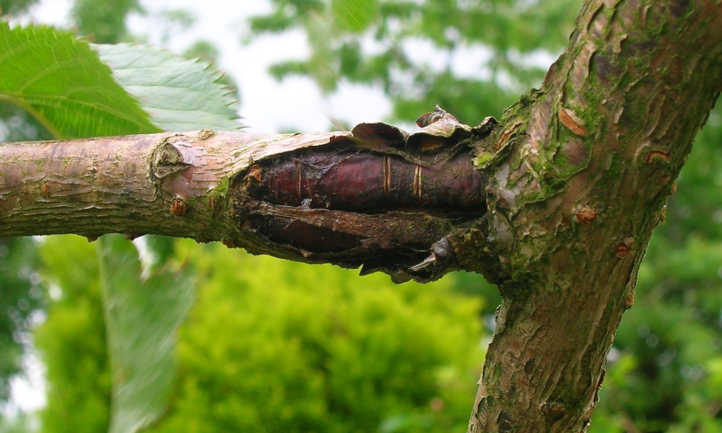
Like citrus canker, bacterial canker appears on the infected branches of plum trees. The cankers grow on the upper branches and cause stunted leaf development. Leaves yellow quickly and are loosely attached to the branches as the disease progresses. The inner bark of the branches takes on red streaking, and it smells sour. In the latest stages, jelly-like growths develop on the bark surface. Left unchecked, bacterial canker causes wilting limbs and the death of plum trees.
This disease is most evident in the spring when bacteria have developed on limbs subjected to splashing rain, low temperatures, and moist conditions. Young trees 2 to 8 years old are most susceptible to infection. Aside from keeping your plum trees healthy, preventing the disease is possible by planting new trees 32 inches above the crown. Plum varieties grafted to Lovell peach trees’ rootstock are resistant to bacterial canker. If the disease presents itself, gardeners can prune off affected branches in hot dry seasons. Prevent root-knot nematodes – which create optimal conditions for bacterial canker – by fumigating soil ahead of transplanting fruit trees.
Bacterial Spot
Bacterial spot is caused by the pathogen Xanthomonas arboricola pv. pruni (XAP), formerly known as Xanthomonas campestris pv. pruni. The leaves of plum trees are yellowed and eventually browned at the tips, as the infection spreads toward the branch. The branch ends take on a blackened and gummy appearance. When present in plum fruit, bacterial spot causes pitting, cracking, water-soaked tissue, and gumming. Late-stage infections cause leaf drop, which reduces the size of plum fruits, and causes sunburn, and cracking. This makes infected trees less productive and more susceptible to winter damage.
As leaf infection presents itself, gardeners spray bactericides on trees to prevent infected fruit. This is most effective in hot, dry seasons and not as effective in spring when conditions are right for the disease. Plant varieties that have been bred for resistance. Remove any gummed branches as they appear. Reduce infections by keeping plums away from high winds and dust that may contain the bacteria. Use neem oil as a preventative measure in early springtime before plum flowers bloom. Do not spray in the growing season, as this prevents pollination.
Crown Gall

Crown gall is a bacterial disease that affects plums and other fruit trees too. Stone fruit trees are most susceptible. It’s caused by the bacterium Agrobacterium tumefaciens which is most commonly found in orchards. The bacteria enter the plum tree through a wound caused by improper pruning, damage from tilling equipment, or boring insects. Symptoms include wart-like swellings called galls on the plum tree crown and root. Each crown gall starts light in color and darkens as the disease persists. The galls multiply and block the absorption of water and nutrients at the root level. Plum tree growth is stunted as a result, and plum trees suffer symptoms of nutrient deficiency and have lowered fruit production.
Preventive measures are key for this disease. Inspect the crown of your plum trees closely before transplanting them. Prune properly to promote air circulation, and avoid tilling close to plum tree trunks. Don’t plant plum trees near infected peach trees or any other infected tree. There is no treatment. Gardeners should remove infected material and burn it or dispose of it in the trash.
Learn More: Crown Gall
Fungal Diseases
An infection of plum trees caused by fungal disease is evident in the fruiting body of the fungal pathogen. This is the latest stage, while earlier symptoms include discoloration of plum tree leaves, plum fruits, and in some cases, necrotic lesions. Here are some of the most common plum tree diseases of the fungal variety.
Armillaria Root Rot
While there are plenty of root rot fungi out there, Armillaria is a fungus specific to root rot in fruit trees. It’s caused by two species of Armillaria: A. mellea and A. tabescens. The earliest symptoms involve the curling of plum tree leaves along the midvein. Leaves bronze and wilt downward. In late stages, the fungus fruiting body presents in the form of cankers that ooze resin. Three characteristics can help gardeners identify Armillaria on plum trees: white mycelial fans growing under the first bark layer; reddish-brown rhizomorphs growing at the main trunk of the plum tree; and clusters of mushrooms growing at the base. The disease is most evident in fall and winter after rain.
The infection spreads to the rest of the tree from the roots. The locus of infection lies in the soil surrounding plum trees and infected plant debris. The most effective control for this disease is to remove the entire plant, especially the large root system and trunks of plum trees. Instead of planting a new plum tree in the same area, allow the soil to lie fallow for several months first. Prevent Armillaria by watering consistently, and avoid wounding the tree during pruning. Provide a good layer of mulch around your plum tree.
Learn More: Root Rot
Black Knot
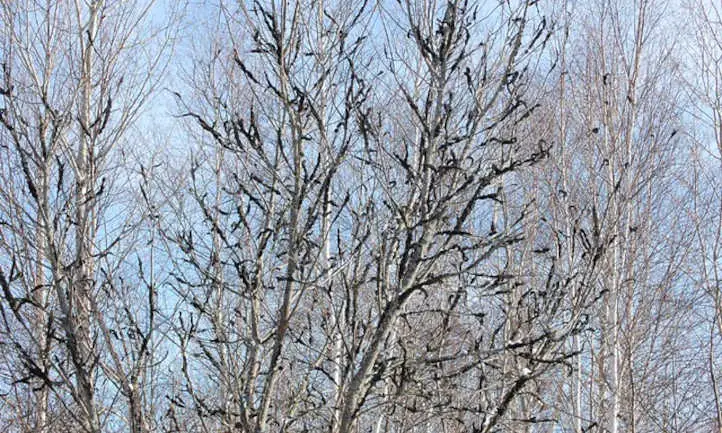
Black knot is a disease caused by the fungus Apiosporina morbosa, which first infects trees in springtime when temperate rainy periods occur. Within 6 hours, rains and winds can send spores to healthy plants, infecting them in the process. The sporification period of black knot continues to early summer. The fungus overwinters in the stems of plum trees, emerging again in spring. Then 1 to 6-inch light-colored black knots appear on the newly grown twigs of the tree. The black knots darken and produce more infectious spores that can spread to other trees. Symptoms generally don’t emerge until the fall. As twigs grow into branches, they wilt and fall off the tree.
Gardeners treat black knot by removing infected twigs 3 to 4 inches below each knot before dormancy passes in winter. Severely infected trees must be removed entirely and burned or disposed of. Spraying trees before they bloom with copper fungicides is an effective prevention method. Reapply every two weeks until bud break occurs. Copper fungicides are only effective on trees that aren’t suffering a severe infection. Removing plant matter, like diseased leaves, from the ground keeps the fungus out of the soil.
Brown Rot
Brown rot is caused by the fungi Monolinia fructicola and Monolinia laxa. The primary source of brown rot infection comes from shriveled fruits that contain spores of either fungus. Both thrive in springtime in temperate and humid environments. Moist flowers are the infection locus, and then the fungi spread to twigs and branches of plum trees. Flowers that make enough contact with spores for infection to set in wilt and die, and a small canker forms in their place. The infection continues through early summer.
Gardeners prevent brown rot by keeping the ground clear of fallen leaves and fruits. Remove any shriveled fruit from the tree as soon as they appear. Prune trees with infected buds and cankers in February or March, avoiding pruning wounds in the process. Fungicide sprays with Myclobutanil or Propiconazole as the active ingredient prevent brown rot on your tree. Apply first when fruit blossoms open. Then apply again 2 to 3 weeks before harvest as fruits ripen on the tree.
Learn More: Brown Rot
Coryneum Blight (Shot Hole)
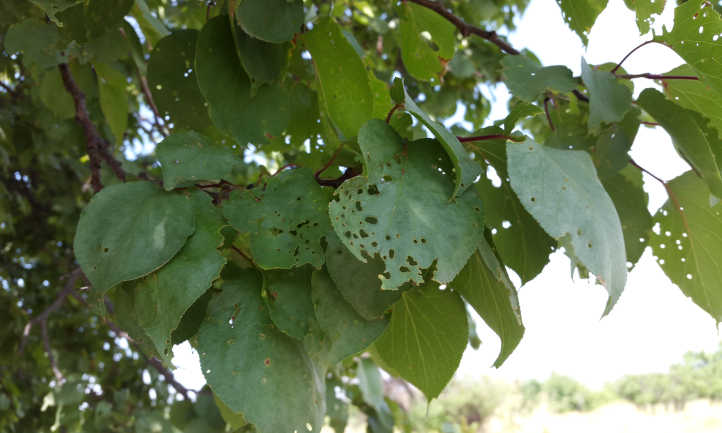
Coryneum blight is caused by the fungus Wilsonmyces carpophilus. It infects the twigs and branches of a plum tree, as well as the blossoms, leaves, and fruit. Spores are produced and spread by wind and rain in early springtime when the first signs of disease show themselves. ¼ inch purple round holes appear on leaves and spread to the rest of the tree as sporification of lesions occurs. The border of the lesions becomes separated from the rest of the leaf creating shot holes. Buds and new shoots become dark purple, and fruit gain sunken areas that start purple and become fuzzy and white.
Treatment options include pruning and destruction of infected wood and spraying fungicides in springtime.
Cytospora Canker (Perennial Canker)
Perennial canker is caused by the fungal pathogens Leucostoma persoonii or L. cincta. L. persoonii. Stonefruit in warm climates is most susceptible to this fungus. The canker is one of the wound-related diseases on a plum tree, resulting from winter damage, pruning damage, or insect boring into the wood of the tree. Early infections present when wounds emit a yellow or amber ooze that eventually produces pimple-like fruiting bodies that sporulate and infects other plants. As the gumming continues, the bark underneath dies, and alternating bands of living and dead tissue appear. As the canker progresses around the tree dry periods can set off nutrient and water flow blockage.
Prevention of perennial canker involves pruning affected limbs and minimizing winter injury by promoting early hardiness of the tree in fall. Prune only when it’s dry, and minimize the risk of winter and summer sunscald with proper drainage, and tree wraps. Bordeaux mixture or chemical sprays applied to freshly pruned wounds keep the tree healthy.
Plum Leaf Spot
Plum leaf spot is caused by the Coccomyces prunophorae fungus. Like most fungal disease, leaf spot thrives in temperate, humid conditions. Spores overwinter in leaf litter and spread through the soil and air via wind and rain. The disease begins with small reddish to purple spots on leaves. Like shot hole, the lesion border will eventually separate from the rest of the leaf. Advanced infections cause spore production on leaves and fruit, reducing fruit yields.
Prevention occurs through managing debris below the tree. Fungicides applied before bud break also prevent the disease. Adequate fertilization prevents plum leaf spot too.
Plum Pocket (Bladder Plum)

Plum pocket is caused by the fungus Taphrina communis. It’s an unusual disease on plum trees that starts as a blister on the skin of the fruit, which eventually grows and swallows it whole. Some fruit grows 10 times its normal size and takes on a spongey texture. In later stages, the fruit is covered in spores developed to spread further. When cut open, infected fruit is empty at the center.
Because plum pocket doesn’t threaten the overall health of a plum tree, management and removal of infected fruit is the most important control. Only when the disease persists for years do experts recommend treating the tree with copper fungicide sprays.
Powdery Mildew
The most common fungus that causes powdery mildew on a plum tree is Podosphaeria oxyacanthae. The fungus infects the leaves and twigs of trees, giving them a powdered appearance. Infected leaves curl upward, and shoot growth becomes distorted and stunted. In the latest stages, white powdery growth develops on leaves, limbs, and buds.
Thankfully there are fungicides specific to powdery mildew that gardeners apply before bud break. They can also be used to treat powdery mildew as it progresses on trees.
Learn More: Powdery Mildew
Rust
In the late springtime season, rust develops on the leaves of plum trees. Plum rust initially presents as mosaic brown spots on leaves and progresses to light brown to purple pustules that contain spores. The plum rust pustules turn into black rot and leaves drop from the tree prematurely. The loss of leaves prevents flowering and the tree won’t bear fruit.
Resistant plums keep this fungus at bay. Pruning for good air circulation also helps prevent damage to leaves. Removal of leaf litter is another preventive method of control.
Learn More: Rust Fungus
Silver Leaf Disease
A less common fungal infection that affects fruit tree and deciduous tree species is silver leaf. The initial signs of infection occur when leaves take on a silvery sheen, which eventually becomes pocked with brown spots. Not visible to the naked eye is the process of separation occurring between the epidermis and the rest of the leaf. The fungus spreads from leaves to small branches, where shelf-like conks develop. These are the fruiting body of the fungal pathogen Chondrostereum purpureum. The disease can easily be eliminated through pruning when the infection is minimal. Do not prune during the growing season, as this promotes infections. There are currently no fungicides for silver leaf but trees generally recover from it after a year or so.
Oomycete Diseases
These diseases are caused by water molds, which are similar to fungi in their behavior, but not true fungi. They are more closely related to algae and green plants, while fungi are more closely related to animals phylogenetically.
Phytophthora Root Rot and Crown Rot
Common in poorly draining garden soil, phytopthora root and crown rot thrive. That’s why the first prevention for these diseases is planting your plum tree in well-draining soil in full sun. Symptoms include reddening and browning of roots. Leaves turn yellow, and leaf buds become malformed. The best control for these water mold pathogens is prevention.
Recently, fungicides have been developed to tackle these problems before they reach the crown. If a plum tree crown is infected, remove the entire tree and the roots for disposal.
Learn More: Root Rot
Viral Diseases

Viral diseases occur when a pathogen makes its way into plant cells and replicates the plant’s DNA. In plum trees, there is only one virus: plum pox virus.
Plum Pox Virus
Plum pox virus (PPV) affects the fruit of plum trees. It’s spread mostly by infected aphids, but may also be spread from infected tree tissue making contact with healthy plum trees. Symptoms include crinkling, curling, or puckering of leaves and yellow incomplete rings on the surface of fruit. The rings turn grey and depressed on fruit and eventually will cause total fruit rot. Ensure your trees come from a reputable source and are aphid-free to prevent the spread. There is no cure for PPV, so removal and destruction of damaged trees are key for prevention as well.



